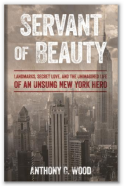The Art of Confrontation: Lessons from the Beverly Moss Spatt Papers
June 20, 2025 | By Matt Goff, 2025 Jeffe Fellow
Saving Papers Update

Another exciting update from our Saving Papers initiative! We have just completed an initial inventory of the papers of Beverly Moss Spatt, a celebrated preservationist, planner, and first female Chair of the Landmarks Preservation Commission (LPC) from 1974 to 1978. This small but mighty collection, donated by her son-in-law, David Peters, is a testament to her career of service. Four bankers boxes and a group of plaques reflect a life of scrappy and unflinching advocacy, warts and all. Although I have only just begun my career in preservation and never met Spatt before her passing in 2023, my work with this collection has, in a way, felt like time spent with one of our profession’s most dogged fighters. I thought it best then for this article to share some highlights of my archival time with Beverly.
The public celebrated Spatt for her reputable confrontations with the government and real estate developers. Meanwhile, these “enemies” of hers, in statements tinged with misogyny, thought her frequent dissents to be the signs of a “loose cannon.” As she states in her 2017 oral history with Village Preservation, a print copy of which is housed in this collection, “I didn’t want to become a dissenter, but…I really believe that I was supposed to do what was good.” Nonetheless, these dissents, saved in the collection as clippings from The New York Times, earned Spatt a reputation, best expressed by a 1967 political cartoon from the Saturday Review. Exasperated fellow planning commissioners look down at Spatt, letting loose both their criticism and begrudging respect: “Some of us are getting mighty sick of these masterful dissents of yours, Spatt.” She saved over 50 copies of this cartoon in her archival collection.
And perhaps her most famous dissent, a report in opposition to the proposed 1969 master plan for New York City, is preserved here as 26 separate copies. In signature biting fashion, she began with a turn of phrase that quickly became a favorite of mine: “After decades of ignoring its mandate to plan comprehensively the New York City Planning Commission has proposed this Comprehensive Plan…thirty years of labor have delivered a mouse.” This dissent, voicing that the new plan did little to actually help the people of New York, was the likely reason for her dismissal from the Planning Commission in 1970.
While public episodes like these have begun to define our memories of Spatt, these records also show the invisible, quiet, and tireless work behind her advocacy. Nestled among her papers is a certificate from 1966 printed on official mayoral letterhead recognizing her service as a “Night Owl for the City of New York.” She received this gag prize for working in city offices through the night from 10:00 p.m. until 6:00 a.m. the next morning.
The “crown jewels” within these records, however, are the many images of important events in preservation history brought about by Spatt during her tenure at the LPC. A photograph of a ground breaking ceremony for renovation work at Battery Park in 1976 is laden with symbolism: Spatt, the lone woman among the city’s governmental string-pullers present, digs the first hole for the project, while a crowd of eager, peace sign-throwing New Yorkers gather behind her. Other images include photographs from public interviews, conferences, and dedication ceremonies, such as the historic landmarking of First Houses in 1974. Spatt’s effort in landmarking these buildings served not only to recognize its importance as one of the nation’s first public housing projects, but the importance of social value in what we preserve and how we do it.
I do not think I could have “met” Beverly at a better time. Given the political barriers to preservation in our modern world, from the stories we are allowed to tell to the growing pressures of development, there is a pressing need for the dissent and advocacy she so embodied. Her records show us that this dissent is not always easy or popular but must be voiced nonetheless to protect the interests of the public. As we prepare these papers for donation to a publicly-accessible repository, I hope that Spatt’s so-called “art of confrontation” can reach and inspire a new generation of preservationists and civic advocates.





